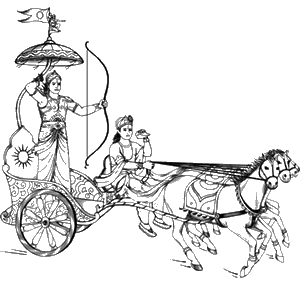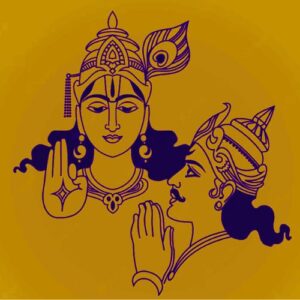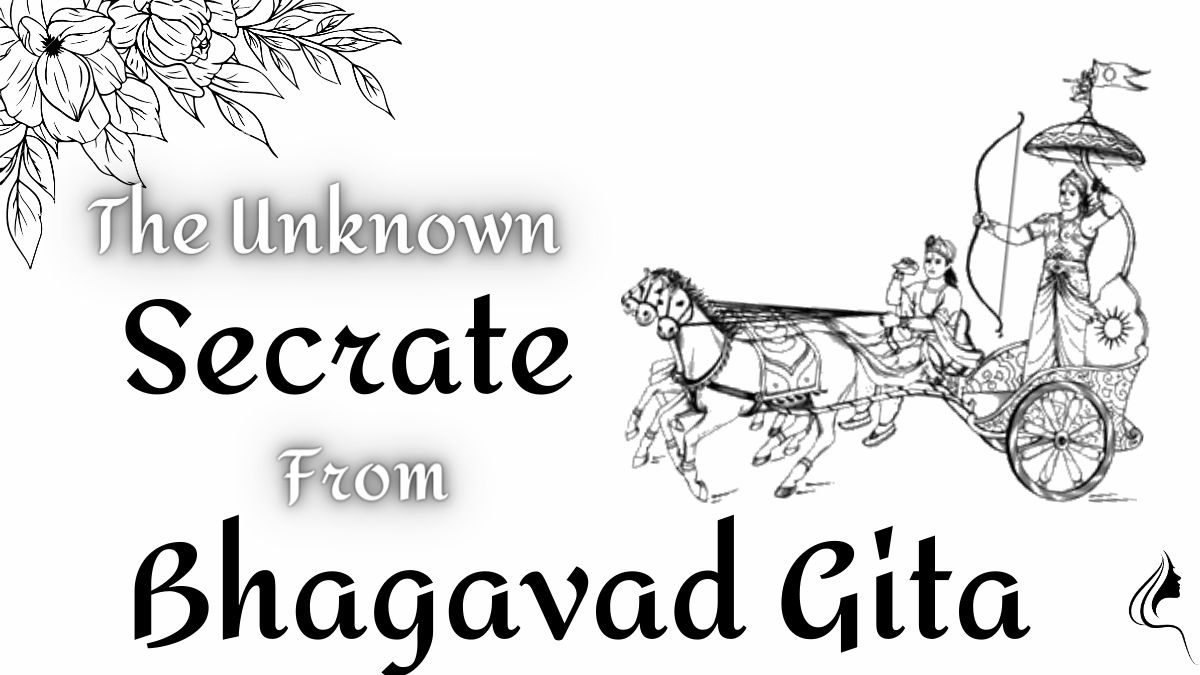Secret from Bhagavad Gita
Table of Contents

The Bhagavad Gita, a timeless scripture of profound wisdom, has captivated the minds of scholars and seekers alike for centuries. Its verses, rich in spiritual and philosophical insights, offer a glimpse into the intricate tapestry of existence and the mysteries of the universe. In this comprehensive exploration, we delve deep into the Bhagavad Gita’s enigmatic verses, deciphering their hidden truths and shedding light on their relevance in today’s world.
The Enigmatic Quote That Inspired Oppenheimer
(00:02) “Now I am become death, the destroyer of worlds.” These immortal words, uttered by American physicist Julius Robert Oppenheimer, find their origin in the 32nd verse of the 11th chapter of the Bhagavad Gita. It’s a testament to the Gita’s timeless relevance that Oppenheimer, often called the father of the atomic bomb, found inspiration in its verses. But what is the deeper meaning behind this quote?
Unveiling the Essence of Kaal
Oppenheimer’s statement, “Now I am become Kaal, the destroyer of worlds,” reflects the profound concept of Kaal in the Bhagavad Gita. Kaal represents time, and in this verse, Lord Krishna reveals his universal form to Arjuna, illustrating that he is the ultimate force behind the cycles of creation and destruction. Understanding Kaal’s significance is the key to comprehending the Gita’s broader message.
The Eternal secret from Bhagavad Gita
(00:27) The Bhagavad Gita is a timeless mystery, even for scientists and scholars. Each encounter with its verses is a revelation, an opportunity to unlock deeper layers of knowledge and insight. It’s a text that continues to astonish, offering fresh perspectives with every reading.

The Unending War of Mahabharata
While the Mahabharata war ended thousands of years ago, the Bhagavad Gita’s relevance endures. The epic battle on the plains of Kurukshetra serves as an allegory for the inner conflicts we all face. Arjuna, the valiant warrior, represents every individual grappling with moral dilemmas, duty, and self-realization.
The Emergence of Multiverse Theories
(01:06) In 1957, physicist Hugh Everett introduced the concept of alternate realities and multiple universes. This groundbreaking idea sent shockwaves through the scientific community, sparking a surge of interest in the multiverse. Remarkably, some chapters of the Bhagavad Gita had explored similar notions long before Everett’s time.
The Vedic Perspective on Universes
The 10th chapter of the Bhagavad Gita hints at a profound truth: our universe is but a fraction of a much grander cosmic tapestry. Shri Krishna’s revelation to Arjuna underscores the interconnectedness of all existence, a concept that aligns with modern multiverse theories.
Shri Krishna’s Universal Revelation
(01:29) In the 11th chapter of the Bhagavad Gita, Lord Krishna unveils his universal form to Arjuna, a vision of cosmic proportions. With countless heads, arms, and celestial weapons, this divine manifestation transcends the boundaries of our comprehension. Arjuna witnesses not only our universe but a multitude of universes within Shri Krishna’s divine form.
The Paradox of Cosmic Time
(01:53) Arjuna’s realization raises a perplexing question: If Shri Krishna is the creator of all universes, why do they operate in different temporal rhythms? The 8th chapter of the Bhagavad Gita elucidates that our universe’s time cycle is governed by Brahma. Bhagavad Purana further reveals that each universe has its own Brahma, overseeing its unique time cycle. The intricacies of these temporal mechanisms remain an enigma.

The Supreme Energy Beyond Brahma
(02:20) While Brahma is revered as the creator of the universe in Vedic tradition, the Brahma Samhita introduces a higher cosmic force—Shri Krishna. As the ultimate creator, Shri Krishna surpasses even Brahma. This revelation challenges conventional beliefs and underscores the depth of the Bhagavad Gita’s teachings.
The Fascinating Case of Shanti Devi
(02:41) In the 1930s, the world witnessed the extraordinary story of Shanti Devi, a four-year-old girl who recalled intricate details of her past life, including her residence, spouse, and untimely demise. Shanti Devi’s case remains a captivating example of reincarnation, a topic that continues to pique scientific interest.
Dr. Ian Stevenson’s Pioneering Research
(03:07) In 1960, American psychiatrist Dr. Ian Stevenson embarked on a groundbreaking study of reincarnation, amassing over 3000 cases of individuals with past life memories. His meticulous research revealed instances of young children recalling memories and places seemingly unrelated to their current lives. Despite criticism, Dr. Stevenson’s work opened a doorway to exploring the mysteries of reincarnation.
Rebirth Explored in the Bhagavad Gita
(03:32) The Bhagavad Gita offers profound insights into the concept of rebirth. Lord Krishna explains that while our physical bodies perish, our souls remain immortal. Past life memories, as popularly known, become imprinted on the soul, transcending the boundaries of mortality. The source of these memories remains a subject of ongoing debate.
The Quest for the Soul
(03:59) Does science acknowledge the existence of the soul? Dr. Wilder Penfield, in his book “The Mystery of Mind,” conducted an experiment that sought to prove the soul’s existence. By artificially stimulating specific brain regions, he raised a profound question: If the brain is merely a biological computer, who programs it? Dr. Penfield’s findings hint at the presence of an intangible force—the soul.
Salvation: Liberation from the Eternal Cycle
(04:23) The Bhagavad Gita introduces the concept of salvation, a state in which the soul breaks free from the ceaseless cycle of birth, death, and rebirth. This transcendent state, as elucidated in the Gita’s 7th and 15th chapters, exists in a universe untouched by sunlight or moonlight, where the Supreme God, Shri Krishna, resides.

The Illusion of Reality
(06:05) The Bhagavad Gita challenges our perception of reality. It suggests that our world is not as it seems—rather, it’s a simulated construct, akin to a computer-generated simulation. This echoes philosopher Nick Bostrom’s simulation theory, proposing that an advanced society, possibly extraterrestrial, controls our reality.
Maya: The Illusion
(06:31) The concept of Maya, or illusion, is deeply ingrained in Vedic philosophy. It posits that our perceived reality is a deceptive construct, a mirage that conceals a deeper truth. Like characters in a video game, we navigate a simulated existence, subject to the whims of a cosmic designer.
Meditation’s Profound Impact
(08:26) The Bhagavad Gita extols the virtues of meditation and yoga, practices that extend beyond spiritual realms. In 1993, an experiment involving Transcendental Meditation and the TM Siddhi Program in Washington DC yielded astonishing results—a 23% reduction in crime within six weeks. The Gita’s teachings on meditation resonate with modern scientific discoveries.
The Ageless Wisdom of the Bhagavad Gita
(09:01) The power of meditation, championed by scientists in the 20th century, aligns with age-old Vedic scriptures. The Bhagavad Gita is a treasure trove of wisdom, unveiling secrets that continue to captivate and inspire. As we unravel its teachings, we realize that there is a wealth of knowledge waiting to be uncovered.
Watch The Original Video Of secret from Bhagavad Gita:
- Protect Yourself from Negetive Energy: शैतानी शक्तियों से बचने उपाय by Sadguru
- How To Become Fearless? Explore the 3 Hard Realities
- Learn To Control Our Mind in Hindi – Kavya Budhiraja Part 1
Disclaimer: In The Above Article We are Discussing about The Above Video Where We have Seen:
On Screen: Twinkle Kapoor
Her Insta ID: https://www.instagram.com/kapoortwinkle/
Did Bhagavad Gita give an explanation for Simulation theory? Was the “Father of the atomic bomb”, J. Robert Oppenheimer inspired by the Bhagavad Gita?
Bhagavad Gita is known as the Holy Hindu text in which Lord Krishna imparts Knowledge to a conflicted Arjuna in the battlefield of Kurukshetra. For ages, Bhagavad Gita has guided us on the right path by teaching us the meaning of true happiness and satisfaction. But, did you know Bhagavad Gita was way ahead of its time? Be it Multiverse or the concept of reincarnation, Bhagavad Gita has talked about many such topics that are still a mystery to science. In this video, we will cover some topics that show us why Bhagavad Gita was a futuristic text! So join us on this journey as we unravel the science behind the Bhagavad Gita.
All The Above Information Is Collected From open sources for The Secret from Bhagavad Gita That Are Publicly Available On the Internet.




3 thoughts on “Did You Know this secret from Bhagavad Gita? Part 1”